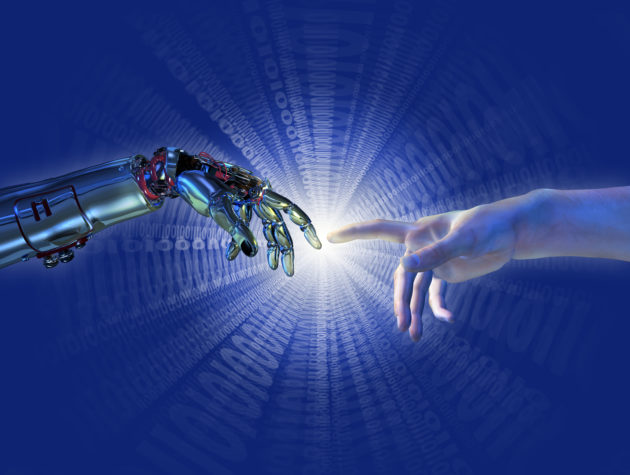BOT or NOT? This special series explores the evolving relationship between humans and machines, examining the ways that robots, artificial intelligence and automation are impacting our work and lives.
Robot and human hands almost touching with a binary burst of light – 3D render with digital painting. A modern take on the famous Michelangelo painting in the Sistine Chapel; titled “The Creation of Adam”.
Credit: Bigstock Photo.
The Obama Administration released a big new report Wednesday on the future of artificial intelligence and made 24 recommendations on the best ways to create an open, inclusive AI industry that crosses boundaries of public and private organizations and international borders.
AI can be a divisive topic, with some excited about the potential innovations and others worried about automation taking over the economy and leaving many people out in the cold. The White House report generally promoted the benefits of AI, but it definitely acknowledged the anxious sentiments that exist about the technology.
The recommendations cover information sharing, better training of the federal workforce to understand AI, federal support of AI research, AI’s effects on cybersecurity and many other issues. The report sums up the crux of AI: It’s an important innovation that could do a lot of good in the future, but it needs to be managed carefully.

“In the coming years, AI will continue to contribute to economic growth and will be a valuable tool for improving the world, as long as industry, civil society, and government work together to develop the positive aspects of the technology, manage its risks and challenges, and ensure that everyone has the opportunity to help in building an AI-enhanced society and to participate in its benefits,” according to the report.
AI has become a point of emphasis for the Obama administration. In addition to the 58-page AI report, the White House released a strategic plan for federally funding AI research and development. Earlier this year, Obama talked about all things AI with MIT Media Lab director Joi Ito and the staff of Wired.
The concept of AI dates back to 1946, and the term was coined in the 1950s. Not much happened after that, until the 1990s when research picked up. One big breakthrough came when human chess champion Garry Kasparov lost to Deep Blue, an IBM supercomputer. The machines went on to pick up a number of victories in the 2000s – most notably, the triumph of IBM’s Watson on the “Jeopardy” quiz show in 2011.
Robot arm holding a chess pawn. Artificial Intelligence. Stock Vector cartoon illustration.
Credit: Bigstock Photo
But AI has been coming up a lot more recently. Great strides in AI were made possible through a combination of increasingly powerful computers and the availability of big data from numerous industries that led to better machine learning and algorithm design.
One of the biggest challenges at the government level is figuring out how to regulate AI innovations. According to the report, there’s a fine line between overregulation that could increase costs and make it harder to complete breakthroughs in the industry, and making sure that the industry is developing safely.
The struggle over regulating drones serves an example. The Federal Aviation Administration issued new drone rules in June, and they took effect in August. The new regulations, known as Part 107, don’t go as far as Amazon and other would-be delivery drone operators might have liked, but the regulations will evolve. For example, the FAA may issue rules that allow flights over people by the end of the year.
Another flashpoint is self-driving cars, where the U.S. government very much wants to lead the way. The Obama administration has proposed spending $3.9 billion in his 2017 budget on research, development and deployment of autonomous vehicles. The report acknowledges the importance of balancing the opportunity to ease traffic congestion, giving people unable to drive more capacity to travel with safety.
“While there is considerable opportunity to reduce the fatalities on roads and highways, current practices result in approximately one fatality for every 100 million vehicle miles traveled. Equaling or exceeding such performance in automated vehicles is a formidable challenge,” according to the report.
The report urges the Department of Transportation to work with researchers and experts in the AI field to share data that can inform potential regulatory decisions. The report envisions a more modernized — and automated — air traffic control system that will accommodate drones as well as crewed aircraft.
Charlie Rose
Charlie Rose interviews robot Sophia. (Via CBS News)
For all the supposed benefits of AI, there are drawbacks as well, namely the potential loss of jobs coming from automation of several industries. The report acknowledged the issue but punted on a solution, recommending a follow-up report to examine the effects of automation on jobs.
“Because AI has the
